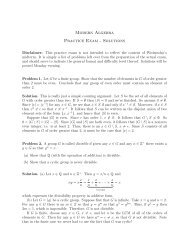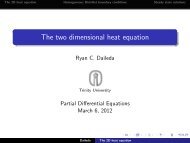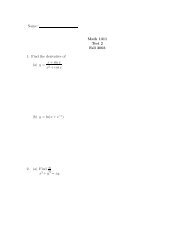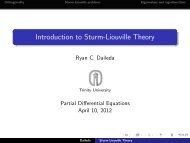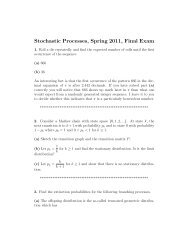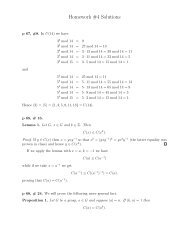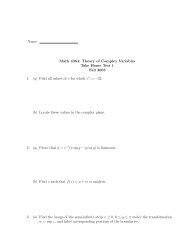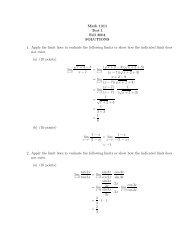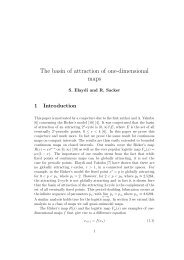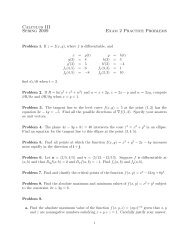Real Analysis Fall 2004 Take Home Test 1 SOLUTIONS 1. Use the ...
Real Analysis Fall 2004 Take Home Test 1 SOLUTIONS 1. Use the ...
Real Analysis Fall 2004 Take Home Test 1 SOLUTIONS 1. Use the ...
Create successful ePaper yourself
Turn your PDF publications into a flip-book with our unique Google optimized e-Paper software.
9. Suppose that f(x) and g(x) are functions defined for x > 0, lim g(x) exists and is finite,<br />
x→0 +<br />
and |f(b) − f(a)| ≤ |g(b) − g(a)| for all positive real number a and b. Prove that lim f(x)<br />
x→0 +<br />
exists and is finite.<br />
Proof. Suppose that lim g(x) = L and |f(b) − f(a)| ≤ |g(b) − g(a)|. If lim f(x) does<br />
x→0 + x→0 +<br />
not exist, <strong>the</strong>re exists ε > 0 and two sequences x n > 0, z n > 0 such that lim x n = 0,<br />
n→∞<br />
lim z n = 0 and for all n |f(x n ) − f(z n )| ≥ ε. For this ε > 0 <strong>the</strong>re exists δ > 0 such that<br />
n→∞<br />
0 < x < δ ⇒ |g(x) − L| < ε 2 . Now for 0 < ̂x 1, ̂x 2 < δ,<br />
|g( ̂x 1 ) − g( ̂x 2 )| = |g( ̂x 1 ) − L − g( ̂x 2 ) + L|<br />
≤ |g( ̂x 1 ) − L| + |g( ̂x 2 ) − L|<br />
< ε 2 + ε 2<br />
= ε.<br />
For this δ <strong>the</strong>re exists N such that n > N, 0 < x n , z n < δ. Hence for n > N |f(x n ) −<br />
f(z n )| ≤ |g(x n ) − g(z n )| < ε, a contradiction. Thus lim f(x) exists.<br />
x→0+<br />
2 + 2 1 2 + 2 1 3 + · · · + 2 1 n<br />
10. Evaluate lim<br />
.<br />
n→∞ n<br />
(You need not give a proof but you should show some work or justification. Quote a<br />
<strong>the</strong>orem or what have you. Calculator results or graphical analysis are not acceptable.)<br />
Proof. Let s n = 2 + 2 1 2 + · · · + 2 1 n<br />
. Then 1 < n2 1 n<br />
n<br />
n < s n < n · 2 = 2. Notice lim<br />
n<br />
2 1 n = <strong>1.</strong><br />
n→∞<br />
Thus s n is bounded. Moreover, we claim that s n+1 < s n . Suppose <strong>the</strong> contrary, that is<br />
s n+1 ≥ s n . Then<br />
Hence<br />
or<br />
(2 + 2 1 2 + · · · + 2 1 n + 2 1<br />
n+1 )<br />
n + 1<br />
≥ (2 + 2 1 2 + · · · + 2 1 n )<br />
.<br />
n<br />
n(2 + 2 1 2 + · · · + 2<br />
1<br />
n ) + n2<br />
1<br />
n+1 ≥ n(2 + 2<br />
1<br />
2 + · · · + 2<br />
1<br />
n ) + 2 + 2<br />
1<br />
2 + · · · + 2<br />
1<br />
n<br />
which is a contradiction.<br />
n2 1<br />
n+1 ≥ 2 + 2<br />
1<br />
2 + · · · + 2<br />
1<br />
n ≥ n2<br />
1<br />
n , n > 1<br />
Hence {s n } is a monotone bounded sequence and thus is converges by <strong>the</strong> Bolzano-<br />
Weierstrass Theorem. Moveover, lim<br />
n→∞<br />
s n = <strong>1.</strong>



